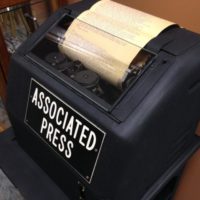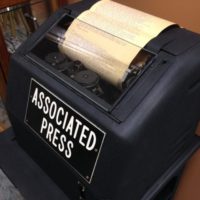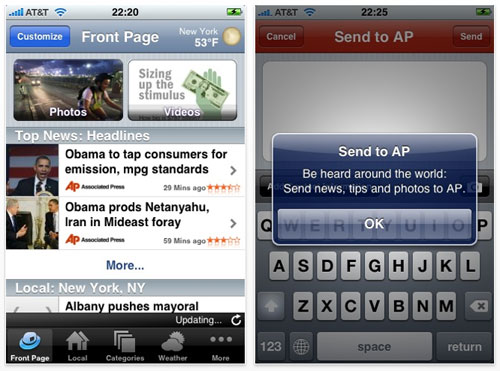In September of 1990, while attending the NAB conference in Boston, I met a recent college graduate named David Gerstmann who had developed software to capture and manage wire service data on a personal computer. He called it WireReady. On a recent visit I asked David to talk about the early days of his company. (10 min)
Tag Archives: wireservice
Teletype
I recall visiting the radio station where my father worked and standing in front of the Associated Press teletype, entranced by the endless stream of words. Who was typing? Where were they? Did they ever stop?
Years later, as a young man, I got a job at the station and came to depend on the AP “wire.” It was our only link to real-time (I’m not sure that phrase even existed in 1972) news and information from outside our little town. The daily newspaper was tossed on the doorstep every afternoon (or you could get the Memphis paper a day late). The three national TV networks gave us a half-hour of national news each evening.
 Our radio station didn’t have a national news network (until 1974) so we relied on the Associated Press newswire for just about everything throughout the day. During a live “board shift” we would dash to the AP teletype (in the transmitter room) and “rip the wire” which involved tearing a long strip of printed wire copy into piles of news, weather, sports, entertainment news, etc. If the paper jammed or the ribbon broke, we missed whatever was fed. If something the AP considered urgent was fed, an alarm bell on the teletype sounded.
Our radio station didn’t have a national news network (until 1974) so we relied on the Associated Press newswire for just about everything throughout the day. During a live “board shift” we would dash to the AP teletype (in the transmitter room) and “rip the wire” which involved tearing a long strip of printed wire copy into piles of news, weather, sports, entertainment news, etc. If the paper jammed or the ribbon broke, we missed whatever was fed. If something the AP considered urgent was fed, an alarm bell on the teletype sounded.
A radio station had to have a wire service. Without it they were limited to playing records and reading local news and school lunch menus. The AP knew this and charged accordingly. Thousands of dollars a year. Contracts were for five years. But there was no alternative.
In 1984 I left the radio station to take a job managing The Missourinet, a statewide news network originating from Jefferson City, Missouri. I worked for (parent company) Learfield Communications for the next 28 years. One of the more interesting projects I worked on was the creation of a low-cost alternative to the Associated Press. We called it Learfield Data (later, Learfield Newswire).
I worked on this (along with bunch of other people) for a dozen years from the late ’80s through 2000. At one time we had 300 subscribers. When the World Wide Web became a reality in the mid-90s it was clear the days of wire services were numbered. Road kill on the Information Highway. You can read (PDF) the story of how it began and ended here: Learfield Data
AP Mobile
During my “on air” days (the ‘70s and early ‘80s), the AP teletype was our station’s connection to the world. During the late 80’s and early 90’s, I spent a good bit of time trying to create a low-cost alternative (mostly for radio stations) to the AP’s wire service. This morning I downloaded AP Mobile to my iPhone.
I have a feeling it will become my default app for news. Text, photos, video… it’s all there. I can flag topics of interest and AP Mobile will “push” those to me. And if I see a story and want to “report” it to AP, the app makes it easy.
Associated Press used to be pretty protective of it’s stories. Perhaps they still are, I would have no way of knowing. The old radio guy in me can’t help thinking of this is a tiny version of the old teletype. And my next thought is, “How could the AP police all of the broadcasters and keep them from using AP stories without paying for it?”
The answer is, I’m afraid, they don’t care. Would I rather have the full-featured, on-demand experience offered by AP Mobile… or hear my local “announcer” read it to me?
Blogosphere as “giant wire service”
Clyde Bentley, a Missouri School of Journalism professor whoresearches user-generated news, speaking at the Future of Journalism conference at Harvard, June 20-21:
The debate over bloggers’ influence “is over,” he said. “Blogging is a numbers game. It’s there and we’ll just have to deal with it.” Noting that 120,000 new blogs a day dwarf the country’s 1,427 dailies, he said editors should treat the blogosphere like a giant wire service. Bentley said that while consumer demand for content decreases, their demand for content navigation increases. “There will always be a place for the journalist who can craft a story better than anyone else, but there will be a bigger place for the journalist who can help media consumers find the information they want.” — Poynter: Centerpieces
AP news on Google
“After a couple years of spirited negotiations, Google has signed agreements with the Associated Press and AFP that will reduce the amount of traffic Google News refers to news sites. First, Google News will start hosting full versions of AP stories instead of linking off to them. And second, Google will begin to filter out duplicates of the same AP story. So you won’t see multiple versions of an AP story from various newspapers, listed with the most recent at the top. Google said the end result is less duplication and a better variety of stories.” — Lost Remote
Do radio stations still subscribe to the AP? It’s been years since I was in radio stations, talking with managers about news and where/how they get it. But even back then, a lot of stations really only relied on AP for state news and high school football scores. Our company offers a “poor man’s wire service” that still has an amazing number of subscribers. [Yo, David. Can you give us an update on this?]
Perhaps the bigger question is… how much do listeners rely on their local radio station for news. I would think a lot. But what’s the order of importance? Local…state…national…world? What can/do I get from my local radio station (on air or online)… and what do I get from a Google search (perhaps on my mobile phone)?
These are interesting times.
Wire Service
 In 1972, radio station KBOA had a little closet in the newsroom that housed two teletype machines. One for the Associated Press and one for the National Weather Service. These typewriter-like printers spewed out line after line of news, sports, weather… everything a radio station might ever want to pass on to its audience. They were loud and smelly and mechanical and the ground through box after box of paper and ribbons. I remember a tractor trailer pulling up to the station every few months to drop off dozens of boxes of each. It was –for all practical purposes– the radio station’s only source for news outside the local community. If someone forgot to feed the beast a new box of paper… or the paper jammed overnight… or the printer ribbon broke… no news. And if the damned thing just broke, you were probably miles from a technician that knew how to fix it.
In 1972, radio station KBOA had a little closet in the newsroom that housed two teletype machines. One for the Associated Press and one for the National Weather Service. These typewriter-like printers spewed out line after line of news, sports, weather… everything a radio station might ever want to pass on to its audience. They were loud and smelly and mechanical and the ground through box after box of paper and ribbons. I remember a tractor trailer pulling up to the station every few months to drop off dozens of boxes of each. It was –for all practical purposes– the radio station’s only source for news outside the local community. If someone forgot to feed the beast a new box of paper… or the paper jammed overnight… or the printer ribbon broke… no news. And if the damned thing just broke, you were probably miles from a technician that knew how to fix it.
I was reminded of those primitive days by a visit from old friend David Gerstmann, founder of WireReady. I met David at an NAB meeting in Boston back in 1991 or ’92. David had just graduated from Tufts University and was exhibiting at the show. He had written an inexpensive software program that could run on the personal computers that were coming into use. Instead of grinding through all of that paper and ribbon, his software could capture and store the information and you just printed out the stories you wanted. Not just from one wire service, but from as many as you had. An amazing idea at the time.
WireReady could also do some word processing tricks that radio news guys found handy. It was affordable, easy to use, ran on the piece-of-shit computer that trickled down to the newsroom and David gave great customer support. He sold a boat-load of WireReady systems and –over the years– introduced new features (networking, digital audio editing, etc).
For a long time, Associated Press and United Press International (UPI) were pretty much the the only sources for world and national news. Not technically a monopoly but they had broadcasters by the balls and they squeezed hard and long. It was a tightly controlled information pipeline but –thanks to the Internet– those days are gone forever. RIP.
Disclosure: The company I work for operates a sort of “poor man’s wire service” (sorry, David) called Learfield Data. It exists today, in part, because broadcasters wanted alternatives to the Big Wire Services of yore.
The wire service of tomorrow?
The Associated Press has unveiled more details of the forthcoming shift to eAP, the Electronic Associated Press, a new initiative to make AP a more interactive network of multimedia content. [CyberJournalist]

